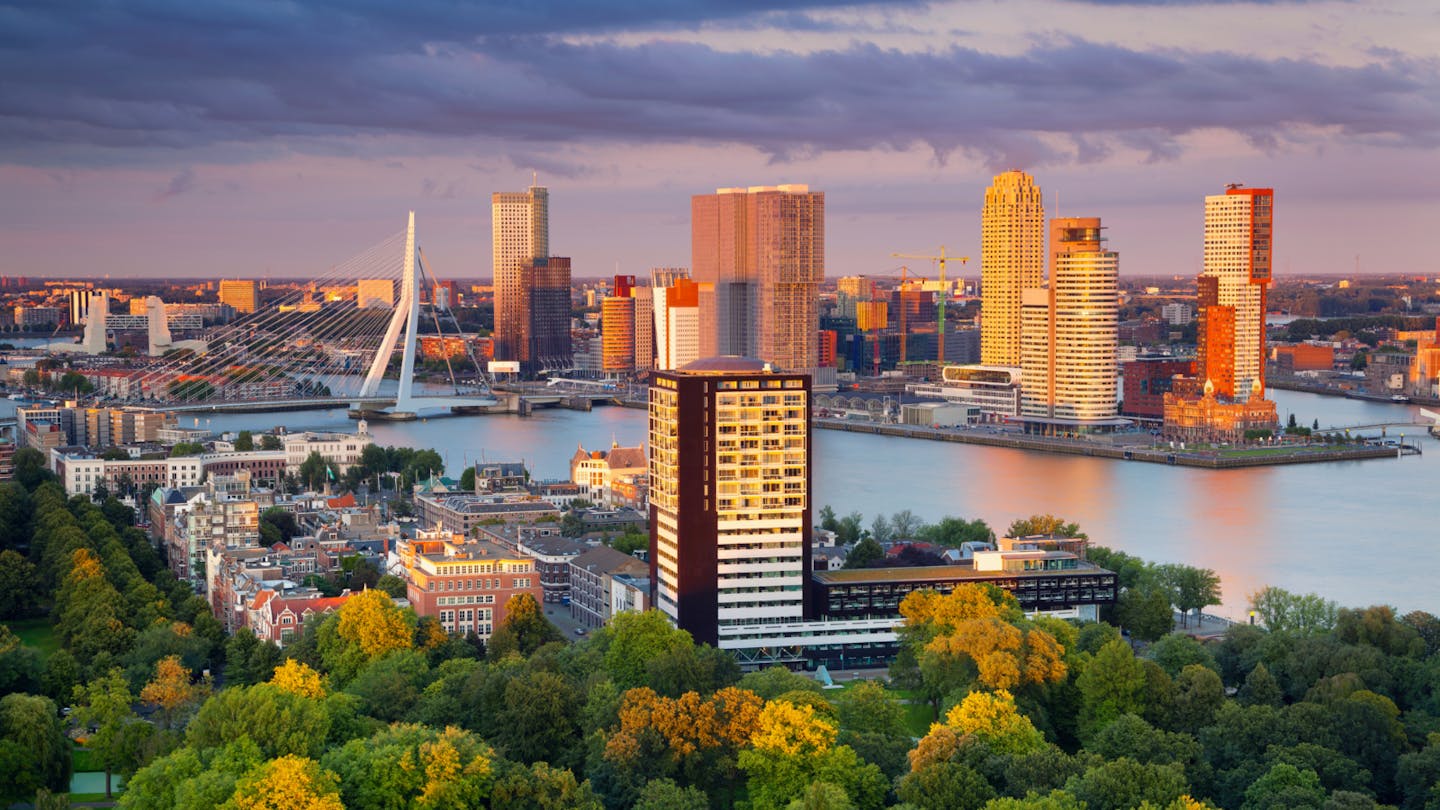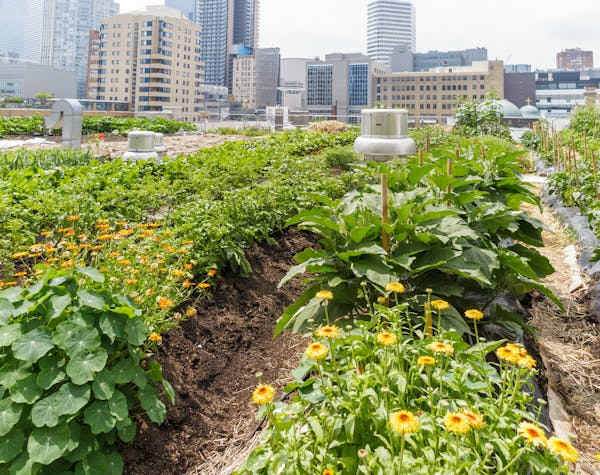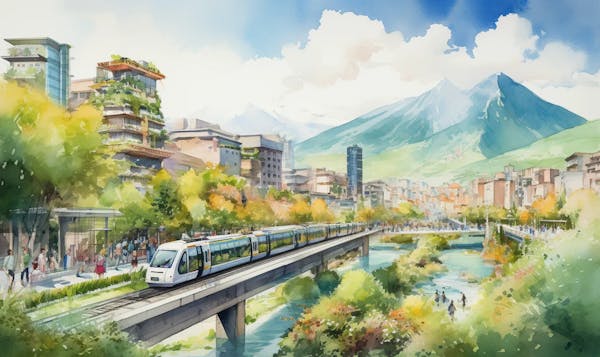From ruins to resilience: How 10 cities rebuilt greener after climate disaster
- Energy Transition
- Renewable Power
- Renewable Transport
- Electric Transport
- Nature Conservation
- Land Conservation
- Urban Biodiversity
- Sustainable Livelihoods
- Public Health
- Policy & Governance
When disaster strikes, it tests the resilience and ingenuity of communities. Around the world, cities battered by climate catastrophes have turned adversity into opportunity, rebuilding smarter, greener, and stronger.
From innovative green infrastructure to nature-based solutions, these ten cities are leading the way in climate adaptation and mitigation. They embraced forward-thinking strategies to rise from the ruins and build a more sustainable future for their residents and inspiring others to take action.
1. A downtown revitalized after the floods: Brandon, Vermont
Brandon, Vermont, was hit hard by the devastating floods of 2011, including Tropical Storm Irene, which left homes and businesses underwater. Instead of simply rebuilding what was lost, the town took a proactive approach to strengthen its infrastructure and resilience.
With support from the Vermont Downtown Action Team (V-DAT) and federal recovery funds, Brandon developed a community-driven revitalization plan that prioritized both economic recovery and flood mitigation. Public workshops led to transformative projects, including streetscape improvements, wayfinding signage, and a major intersection redesign to improve flood resilience.
A key feature of this redesign was the installation of a six-foot-tall, twelve-foot-wide, 230-foot-long overflow culvert beneath US Route 7 (Center Street) to divert excess water from the Neshobe River during heavy storms. Normally dry, the culvert activates in high-water events, channeling floodwaters safely away from downtown.
Completed in 2017, the culvert proved its effectiveness almost immediately, preventing flooding during a major storm that same year. Brandon demonstrates how smart urban planning and resilient design can protect communities from future climate disasters.
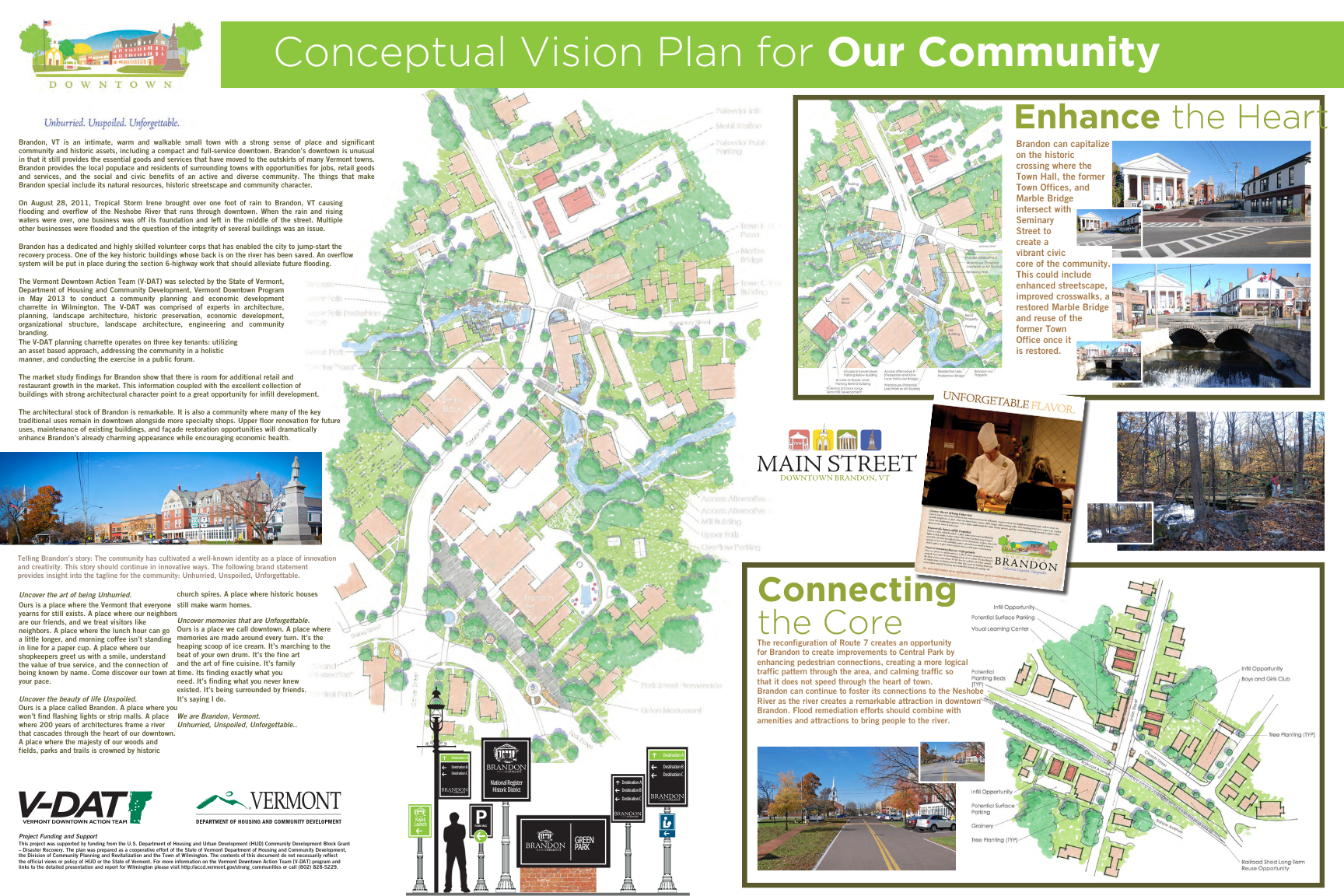
Brandon’s illustrative poster highlights the V-DAT recommendation for downtown, displaying the community brand, the streetscape recommendations and wayfinding signage. Image Credit: Mainstreet.org.
2. Beavers to the rescue: Pickering, England
For years, the town of Pickering in North Yorkshire suffered from repeated, devastating floods, with heavy rains turning its streets into waterways. Traditional flood defenses were deemed too costly, leading local conservation groups and authorities to take an unconventional approach—turning to nature. As part of the Slowing the Flow project, beavers were introduced to the River Severn near Cropton Forest, and their impact has been extraordinary.
Nature’s industrious engineers have built a massive 70-meter dam—the largest beaver-constructed dam in England—creating a natural flood barrier that slows water flow and prevents downstream flooding. In addition to reducing flood risks for Pickering’s 7,000 residents, the beavers have revitalized local biodiversity, attracting otters, kingfishers, and other wildlife to the area. By working with nature instead of against it, Pickering has become a model for flood resilience, proving that sometimes the best engineers don’t need blueprints—they just need logs and a little determination.
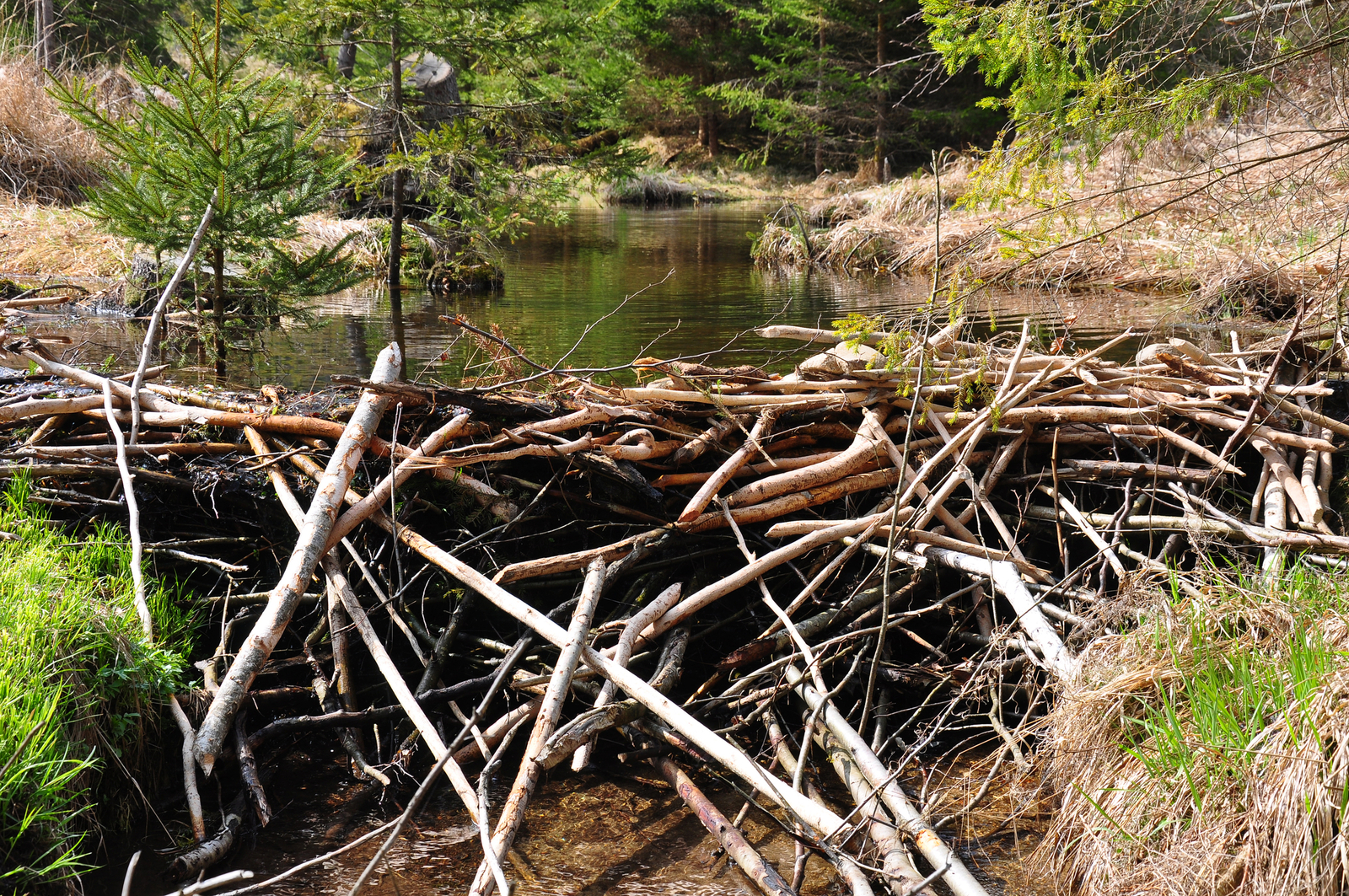
A robust beaver dam, like the one that has stopped flooding in Pickering. Image Credit: Rbiedermann | Dreamstime.com.
3. A tornado sparks a green revolution: Greensburg, Kansas
When an EF5 tornado tore through Greensburg, Kansas, it obliterated 95% of the town, leaving half of its 1,600 residents homeless. Faced with the possibility of losing the town altogether, local leaders knew they had to do something bold. Instead of simply rebuilding, they committed to transforming Greensburg into a world leader in sustainable development.
The town secured state and federal grants, issued local bonds, and created property tax incentives for businesses that adhered to green building standards. The gamble paid off—Greensburg now has the most LEED-certified (Leadership in Energy and Environmental Design) buildings per capita in the US, and all of its electricity comes from wind energy.
In addition to sustainability, Greensburg prioritized resilience against future tornadoes. Many of its new buildings incorporate reinforced structures designed to withstand extreme winds. The town’s Eco-Homes take inspiration from the grain silos that survived the tornado, featuring a circular design and precast concrete walls engineered to endure winds up to 240 mph. These structural upgrades ensure that Greensburg is not only greener but also better prepared for future natural disasters.
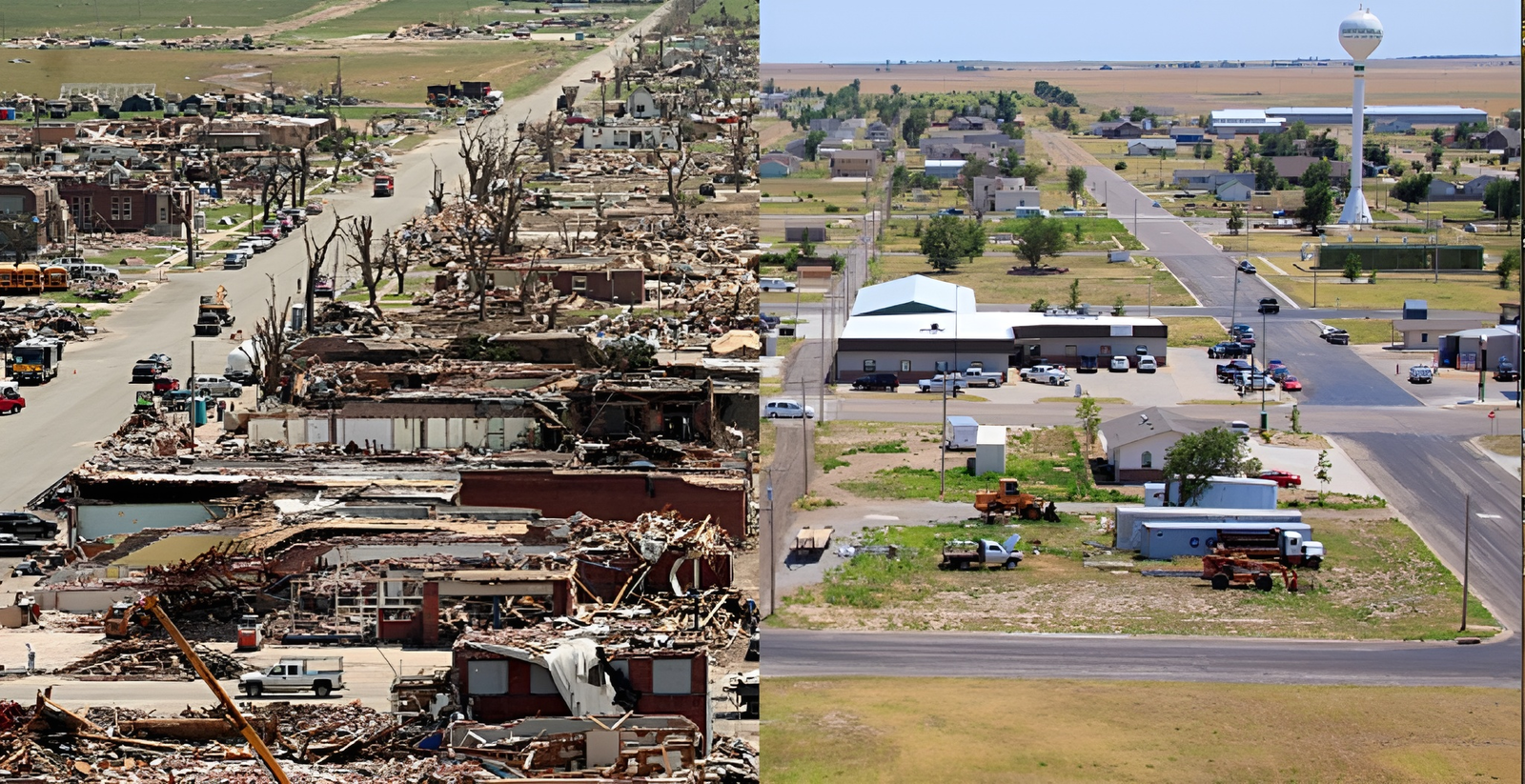
Then and now: A tornado leveled most of Greensburg on May 4, 2007. It has since been rebuilt as an environmentally friendly city. Image Credit: Greg Henshall and Steve Zumwalt of FEMA via Governing.com.
4. Strengthening the foundation of homes and the community: Yogyakarta, Indonesia
On May 27, 2006, a powerful earthquake struck the Yogyakarta region in central Java, Indonesia, claiming more than 5,700 lives and leaving nearly a million people homeless. The destruction was overwhelming, reducing homes, roads, and cultural landmarks to rubble. The village of Ngibikan, located less than 10 kilometers from the quake’s epicenter, was completely destroyed.
But Yogyakarta’s people refused to let the disaster define their future. With strong leadership, international aid, and an unwavering spirit of community self-help, they launched a reconstruction effort that prioritized earthquake-resistant infrastructure, disaster preparedness, and sustainable rebuilding practices.
In the village of Ngibikan, under the leadership of community leader Maryono and with design guidance from local architect Eko Prawoto, villagers came together to rebuild 65 homes in less than 90 days. Drawing inspiration from the traditional Javanese limasan house, they incorporated innovative modifications to ensure the structures remained lightweight while enhancing their resilience against future earthquakes.
Recycled materials salvaged from the rubble were repurposed for construction, reducing waste and preserving cultural heritage. This grassroots effort, not only restored the physical environment but also strengthened the gotong royong—the deep-rooted spirit of mutual aid that defines agrarian communities in Indonesia.
Today, Yogyakarta has not only recovered but thrives as a cultural, educational, and tourism hub in Southeast Asia—proof that a united community, grounded in tradition and innovation, can rise from disaster stronger and more sustainable than ever.

View of a street in Ngibikan after the village reconstruction project. Image Credit: AKAA / Ahkamul Hakim, AKDN.
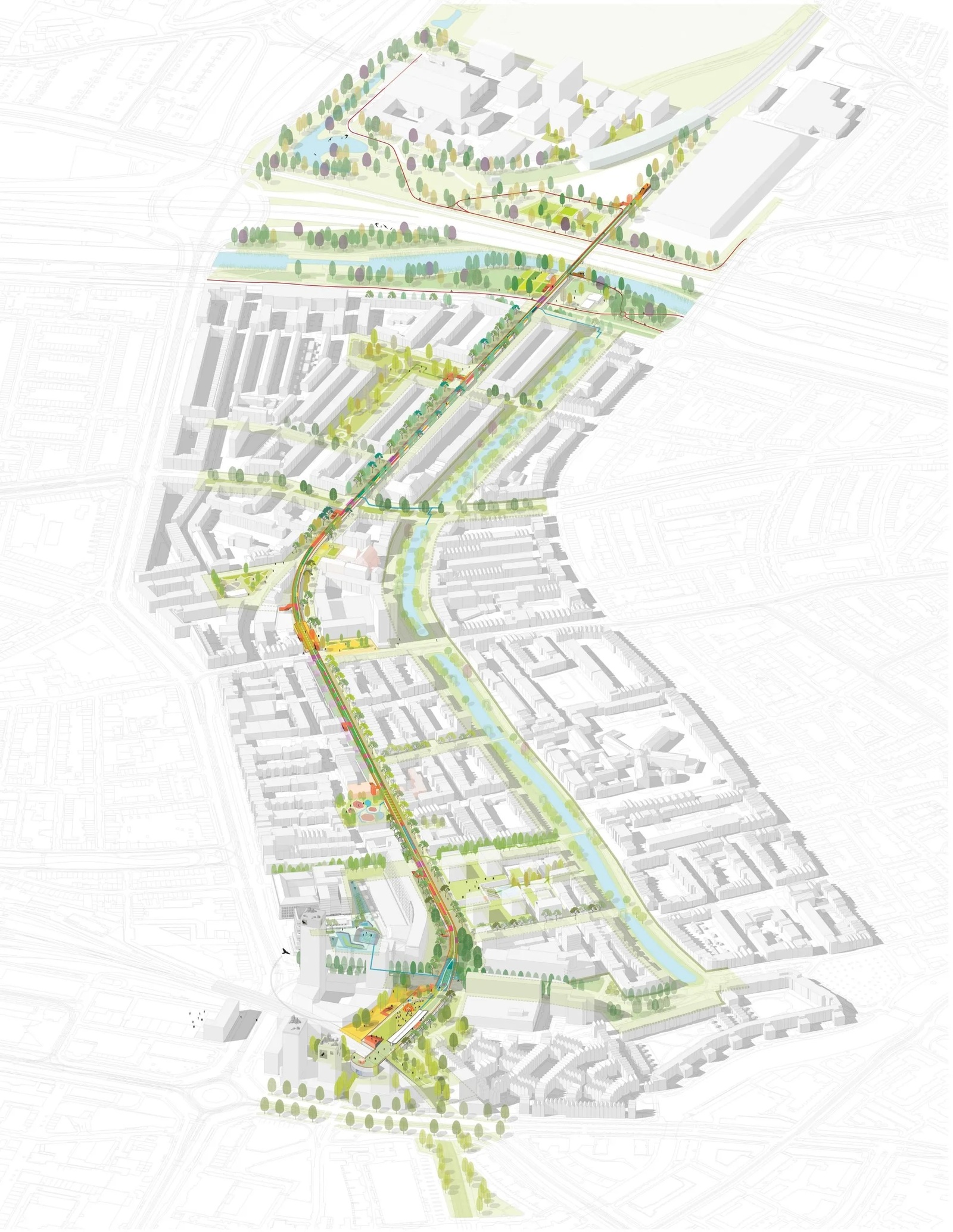
Map of the Hofbogenpark. Image Credit: De Urbanisten via Architects Journal.
5. The “Sponge City” of Europe: Rotterdam, Netherlands
Built on a delta and historically protected by dykes, Rotterdam has long battled the challenges of rising seas and extreme rainfall. However, its vast concrete landscapes made it increasingly vulnerable to flooding. In response, the city embraced the “Sponge City” approach, turning public spaces into multi-functional, water-absorbing landscapes.
One of its most celebrated projects, Hofbogenpark repurposes an abandoned railway viaduct into an elevated green corridor with a self-sustaining water system, improving both flood resilience and urban biodiversity.
By redesigning its infrastructure to work with nature rather than against it, Rotterdam has become a global leader in climate resilience, showing that cities can thrive even in the face of rising waters.
6. Powering the future with the sun: Bulawayo, Zimbabwe
As Zimbabwe’s second-largest city, Bulawayo has faced significant climate challenges, including prolonged droughts, water scarcity, and energy insecurity. But rather than relying on outdated infrastructure, the city is embracing next-generation technology to create a more sustainable future. With ambitious goals to become a zero-carbon urban center, Bulawayo is transitioning from fossil fuels to renewable solar power, replacing its aging power station with a clean energy alternative.
The city is pioneering Trackless Trams—an innovative, energy-efficient transit system—to reduce emissions and improve mobility. Smart technologies are also being introduced to modernize the electrical grid, making energy distribution more efficient and reliable. Researchers are even exploring carbon sequestration opportunities in the city’s public green spaces to capture carbon and improve air quality.
By leapfrogging over traditional technologies and investing in cutting-edge solutions, Bulawayo is proving that sustainable urban development is not just possible—it’s the key to thriving in a changing climate.
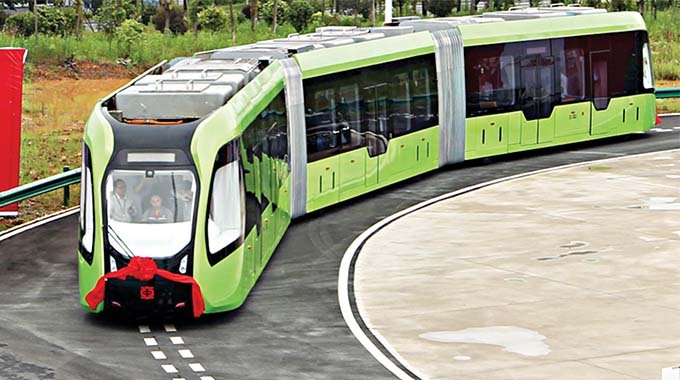
Example of a Trackless Tram. Image Credit: Essex CC, Wiki Commons.
7. Turning floods into parks: Hoboken, New Jersey
Once notorious for chronic flooding, Hoboken has transformed its vulnerability into an opportunity for climate resilience. Nearly 80% of the city sits on a floodplain, and when Hurricane Sandy struck in 2012, storm surges inundated streets, homes, and businesses with 500 million gallons of water.
In response, Hoboken developed ResilienCity Park, a five-acre recreational space that doubles as a massive stormwater retention system. Beneath its playgrounds, basketball courts, and green spaces lies an underground tank capable of holding one million gallons of water, while rain gardens and permeable surfaces absorb an additional million.
Funded in part by FEMA, this multi-functional park is just one of several resiliency projects designed to keep floodwaters out of homes and businesses. More than just an engineering feat, it serves as a model for climate-adaptive infrastructure—blending flood mitigation with community spaces, education, and urban renewal.
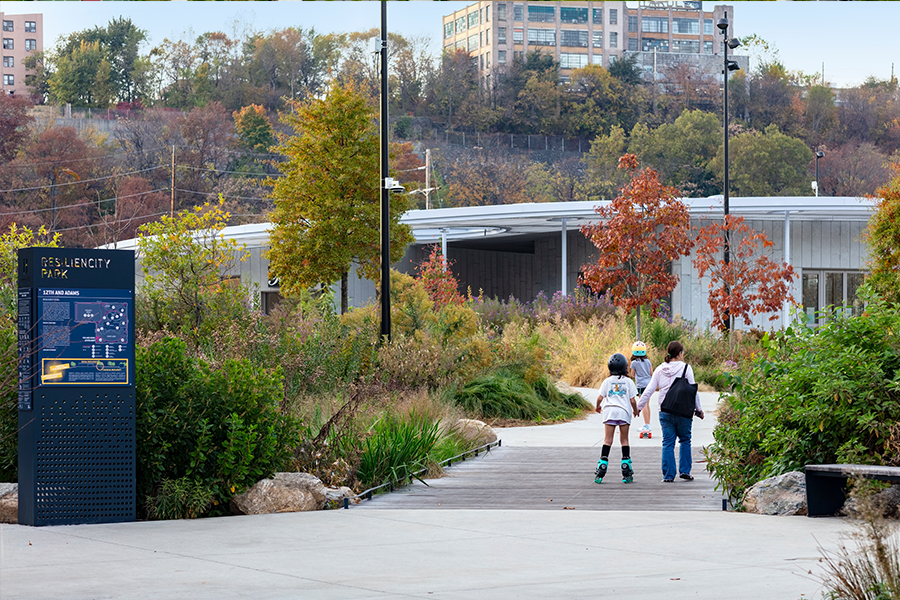
ResilienCity Park in Hoboken, New Jersey. Image Credit: The OLIN Studio.
8. Ingenuity inspired by ancient wisdom: Sanya, China
Once plagued by flooding and pollution, Sanya transformed Dong’an Wetland Park into a Sponge City solution, restoring natural water absorption and resilience. Replacing concrete flood walls with eco-friendly embankments, the 66-hectare park now manages stormwater through ponds, dykes, and terraces that reduce flooding and purify runoff.
Inspired by ancient cut-and-fill farming techniques, engineers created a central lake with islands planted with banyan trees to cool the area and support biodiversity. Elevated walkways weave through the canopy, offering residents and visitors a green urban escape while integrating flood control with recreation.
Built in under a year at a fraction of traditional costs, the park has curbed flooding and become a national model for climate resilience. Dong’an Wetland Park proves that sustainable water management can revitalize ecosystems, enhance livability, and drive economic growth.
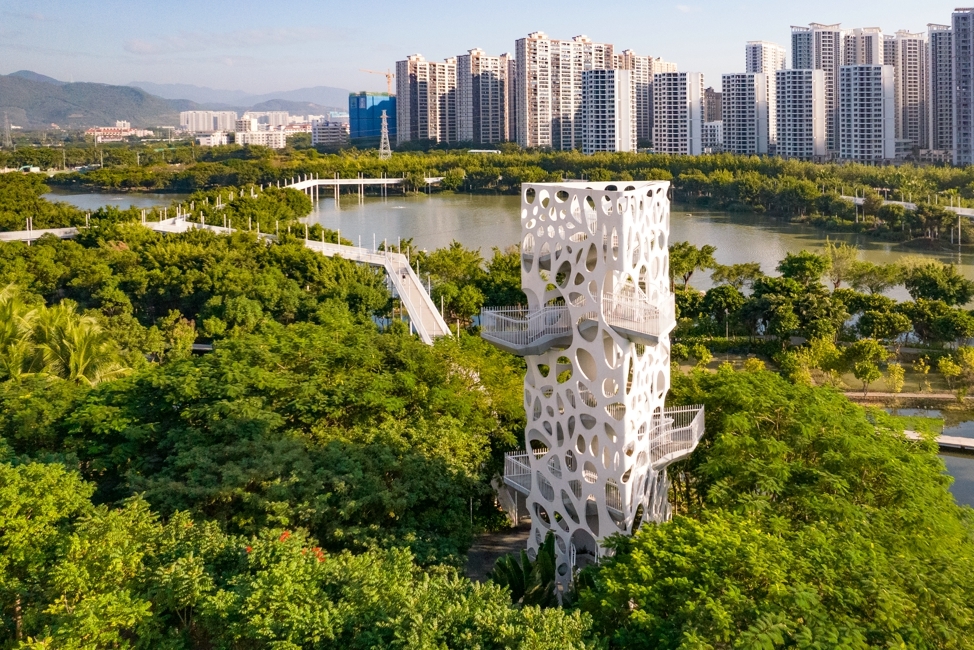
Sanya Dong'an Wetland Park. Image Credit: Turen Scape.
9. Reclaiming the streets from heat: Karachi, Pakistan
In the face of increasing urban flooding and extreme heat, Karachi is transforming its streets into climate-resilient public spaces. Led by Yasmeen Lari, Pakistan’s first woman architect, the Climate-Smart Eco-Streets initiative replaces impervious concrete with low-carbon, permeable terracotta pavements that absorb rainwater, reducing flood risks and cooling the environment.
The project began with Denso Hall Rahguzar, a pedestrianized street in Karachi’s historic core, proving that simple, localized solutions can create lasting climate resilience. By prioritizing people over cars, limiting demolitions, and fostering green spaces, Karachi’s eco-streets are revitalizing urban life, supporting local commerce, and mitigating climate risks.
As Yasmeen Lari emphasizes about climate change, “It is time for all of us to become aware of the gravity of the situation.” Through eco-conscious urban planning, Karachi is pioneering a new model for sustainable, people-centered cities—one street at a time.

Before and after: Denso Hall Rahguzar. Image Credit: @densohallrahguzar, Instagram.
10. Turning rooftops from grey to green: Portland, Oregon
Portland’s "Grey to Green" Initiative, launched in 2008, is transforming the city’s approach to stormwater management. By expanding tree canopies, restoring waterways, and promoting green roofs, the initiative reduces the reliance on concrete infrastructure while improving flood resilience and urban biodiversity.
Since its inception, Grey to Green has added 36,000 substantial trees across Portland, enhancing air quality and reducing urban heat. Volunteers, city staff, and local organizations like Friends of Trees have played a crucial role in these efforts, planting thousands of trees in neighborhoods with low canopy cover. Additionally, bioswales and eco-friendly embankments have been integrated into public spaces, slowing runoff and preventing pollution.
Beyond flood control, the initiative has reshaped Portland’s urban landscape into a greener, more livable environment. The city's investment in nature-based solutions demonstrates how urban planning can balance sustainability, infrastructure, and community engagement.
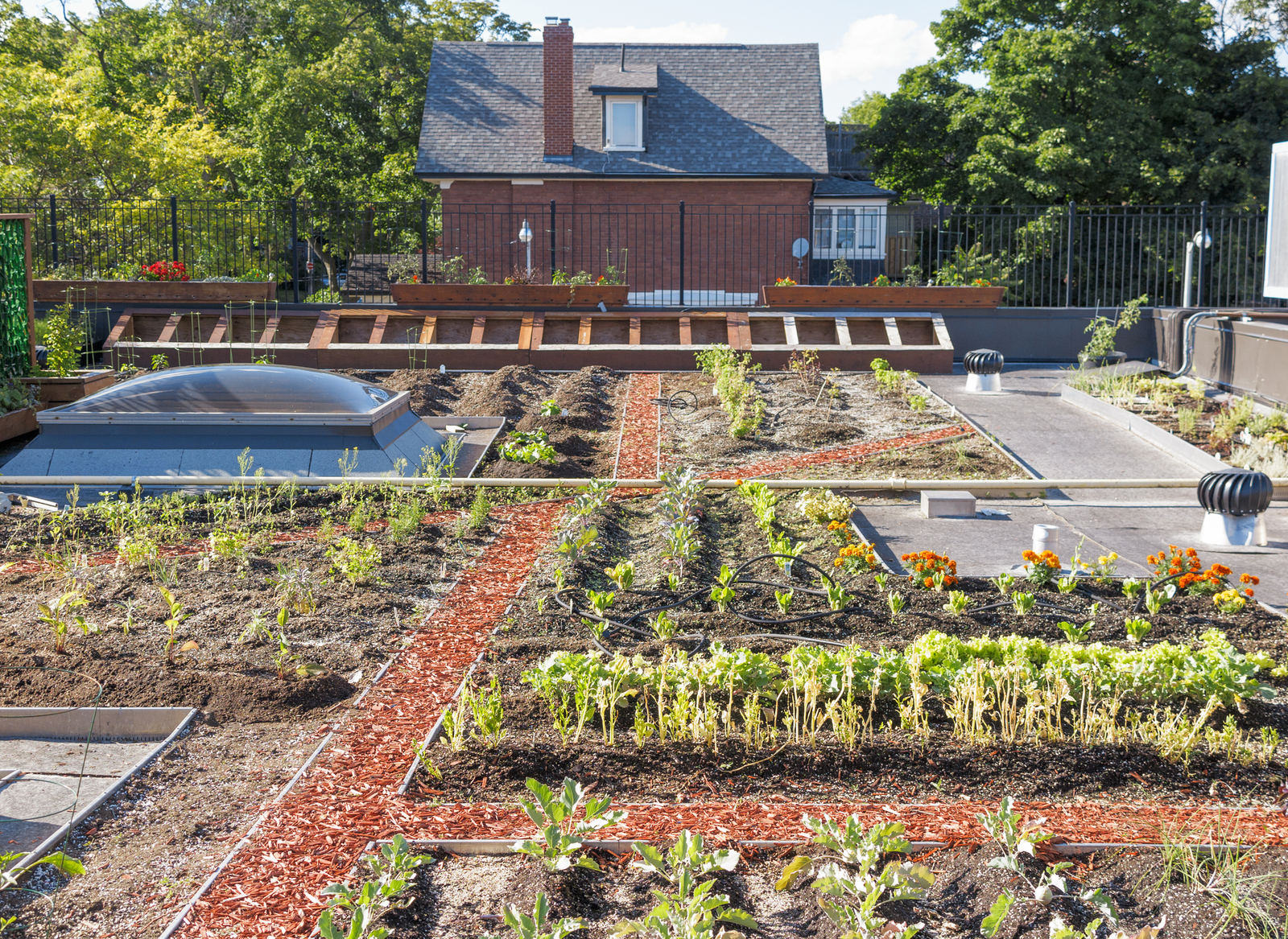
Rooftop gardens like the ones that can be seen throughout Portland. Image Credit: Alisonh29 | Dreamstime.com.
Building a more resilient future
These ten cities prove that adversity can be a catalyst for transformation. By embracing innovative, nature-based solutions, they have turned past disasters into opportunities for a more sustainable and resilient future. From flood-resistant parks to urban forests and renewable energy, each city offers a blueprint for others facing similar climate challenges.
Their success underscores a powerful message: climate resilience is possible when communities, governments, and innovators work together. As climate risks continue to grow, these cities serve as an inspiration, showing that with vision and commitment, we can build a world that is greener, safer, and better prepared for the challenges ahead.
Support Climate Solutions